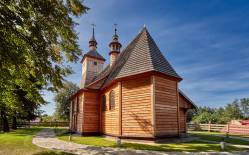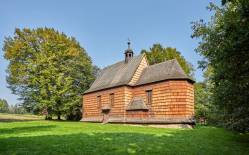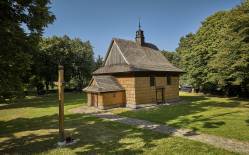We do not know exactly when the parish in Sonina was established. We do know, however, that in the second half of the 1500s, after Protestants took over the church in Łańcut, the church in Sonina was a seat of the Łańcut parish. The present church of St. John the Baptist was built in the 17th century and later was remodelled many times.
The church is oriented eastward. On the northern side the nave is adjoined by a chapel and two store rooms. The church is uniformly covered with a gable roof, above the nave topped with a bell turret. The tower, tapering towards the top, ends with a faux chamber, and features a pyramidal roof with a turret. The church is a log structure, while the tower is a post-and-frame type of construction.
Over the main nave and chancel, we can see wooden pseudo-barrel vault, and in the vestibule – a recessed ceiling. A porch leads into the nave through a low and broad opening. The naves are separated by pillars. Between the nave and the chancel there is a rood beam with the Crucifixion Group. The choir gallery, with a straight-line parapet, is supported on two pillars.
The high altar and one side altar, early Baroque in style, date from the 1600s. The other side altar, eclectic in style, was added in the 19th century. The interior furnishings also include pipe organs from 1892. Ornamental wall paintings were added in the 1960s, and replaced the older polychrome decorations by Władysław Chodzicki from 1893. There are also a number of paintings and sculptures from various periods between the 17th and the 19th century.
Around the church we can still see relics of ramparts.
Photo: Krystian Kłysewicz
Gallery

Recommended venues on the Trail



This website has been modernized with the financial support of the European Union under the Cross-Border Cooperation Programme Poland-Belarus-Ukraine 2014-2020. The responsibility for its content lies solely with the Podkarpackie Regional Tourism Board and cannot, in any case, be treated as a reflection of the position of the European Union, the Managing Authority, or the Joint Technical Secretariat of the Cross-Border Cooperation Programme Poland-Belarus-Ukraine 2014-2020.













